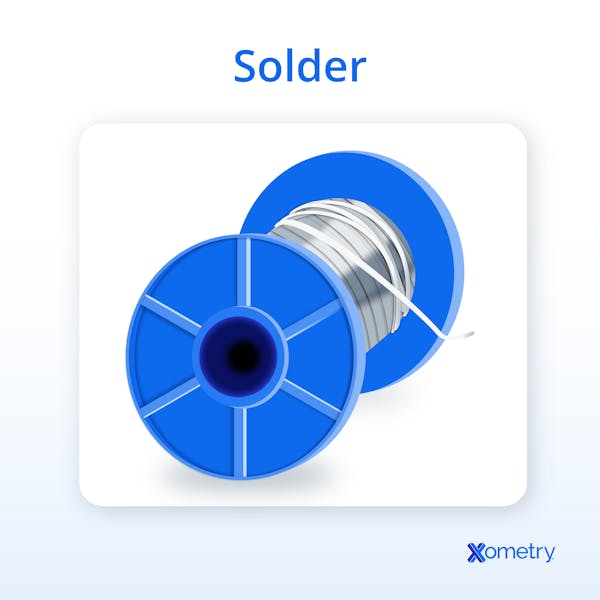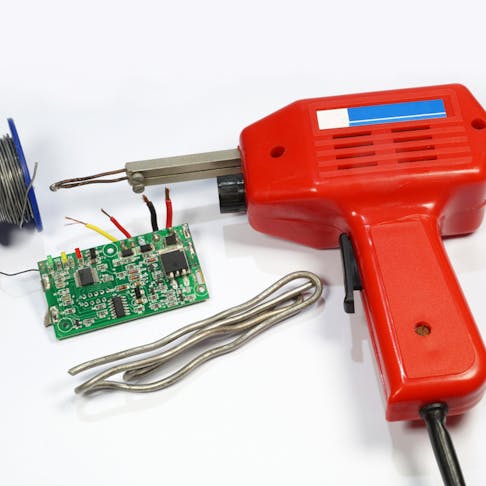Soldering is a central and critical group of techniques in electronics, copper-based plumbing, and the engineering of delicate parts. It involves joining two or more metal components together by melting a lower-melting-point filler metal, the solder, and allowing it to flow into the joint. This creates a strong and (where relevant) electrically conductive bond when it cools and solidifies. This process is key to connecting electrical components onto printed circuit boards (PCBs) and assembling intricate mechanical and jewelry parts.
This article will review the eight commonly used forms of solder and their applications and necessary specializations in processing.
1. Lead-Based Solder
Lead-based solder is the earliest type of soldering alloy that historically contained a significant amount of lead. It often contains small quantities of antimony and tin to affect various properties. For example, tin improves the wetting quality of solder as well as its mechanical strength and fatigue resistance. Antimony in small quantities also improves the fatigue properties of lead solder, particularly at higher operating temperatures.
The most common alloy, less used now, is 60/40 tin/lead, which has a melting point of 183–190°C.
Lead-based solder was commonly used in electronics, plumbing, and other applications due to its low melting point, ease of use, and reliability. Concerns about the environmental and health impacts of lead exposure have led to restrictions and regulations limiting its use. In many regions, such solder has been largely phased out, replaced by materials that are safer for both operators and the environment. Lead-free solder alloys offer similar performance while reducing the risks associated with lead contamination and toxicity, but can be considerably harder to work with.
2. Lead-Free Solder
Lead-free solder is the lower-toxicity alternative that has largely displaced traditional solder in common use, particularly in PCBA (printed circuit board assembly) soldering and plumbing. It offers greater safety to health and a lower environmental impact. Lead-free solder alloys typically consist of a combination of metals, such as tin, silver, copper, and small amounts of other elements like bismuth or zinc. These alloys have a higher melting point compared to lead-based solder but still provide effective and reliable bonding, though require higher skill levels. Widely used lead-free solders include tin-copper and tin-silver-copper (SAC) alloys, each suited to different cost and performance requirements.
These alloys commonly have melting points of around 217°C. SAC (Sn-Ag-Cu tin-silver-copper) is a blend popular in Japanese electronics factories, although the higher silver content does raise the price. Lower silver and silver-free alternatives are more widely used.
Lead-free solder eliminates most toxicity risks, making it safer for workers and reducing the environmental impact during manufacturing and disposal. Although these materials have become industry-standard, they require more advanced and controlled soldering techniques at higher temperatures, and are less tolerant of process variation and contaminants.
3. Rosin-Core Solder
Rosin-core solder is a type of solder that is in decreasing use, although it is still popular. The metal alloy is formed as a tube, with its hollow core filled with rosin. Rosin is the common name for natural pine tree resin, and it was the earliest form of flux used in soldering.
When heated, rosin flux decomposes to form weak organic acids that remove light oxidation and promote wetting. It helps improve joint quality by reducing oxidation and ensuring a cleaner, more uniform finish.
Rosin-core solder is popular due to its convenience, as it combines both the soldering material and flux in one, simplifying the soldering process. It was commonly used for electrical connections in electronics, circuit boards, and various small-scale soldering applications, but rosin flux is of low efficacy in lead-free soldering. Since it is unreactive (chemically passive) when cooled/solidified, both pure rosin and modern, additive-rich rosin fluxes are safe for electronic use.
4. Acid-Core Solder
Acid-core solder is a specialized type of solder wire primarily used in plumbing applications, especially for soldering copper pipes and fittings. The aggressive acid acts as a powerful flux to clean the oxides from the copper surfaces. In this way, the solder can wet and flow effectively, penetrating copper-to-copper joints and forming a clean, fully coupled meniscus when the solder is molten.
This flux core is typically a mixture of zinc chloride or ammonium chloride and serves a crucial purpose in plumbing. Without aggressive fluxing, creating reliable copper joints is difficult, as surface oxidation inhibits proper wetting and bonding.
Due to its corrosive nature, acid-core solder is not suitable for electrical applications, in which other minimally corrosive flux core solders are used to prevent damage to sensitive electronic components.
5. Flux-Core Solder
Flux-core solder is a generic term for any type of solder alloy that has one or more internal galleries running through it that are filled with flux that assists in making clean and efficient joints.
The flux can be natural rosin, though modern formulations often include additives to improve oxide removal and reduce residue. Isopropyl alcohol is commonly used in liquid flux formulations, but not in flux-core solder wire. Flux can also be organic, mild-acidic flux, suitable for electronics, but not strong enough to solder heavily oxidized copper surfaces. Inorganic-acid flux is more strongly acidic and can clean more intractable copper surfaces, but leaves residues that will damage electronics (so it is not used in that area).
6. Solid-Core Solder
Solid-core solder refers to solder wire that lacks a built-in flux core and requires external flux for proper wetting and oxide removal. Most solder alloys, including eutectic tin-lead (Sn63/Pb37), SAC (tin-silver-copper) lead-free alloys, and RoHS-compliant variants, are available in solid-core form for use in applications where separate fluxing is preferred or required.
7. Silver-Alloy Solder
Silver soldering is a considerably higher temperature process, as silver has a higher melting point. The liquefaction temperature depends heavily on the alloy, ranging from around 300°C up to 420°C for high silver content. This process is often referred to as silver brazing.
The silver-alloy solder rods are solid core and are used in conjunction with aggressive fluxes that typically contain combinations of fluoroborates, tetraborates, boric acid, and other compounds designed to remove oxides and promote wetting. These are white pastes or powders (to be wetted for use) that form an oxygen-excluding, acid, and oxide-removing glass-like layer that encourages wetting and flow.
8. Lead-Alloy Solder
Lead-alloy solders were among the earliest types used and are often modified with elements like tin, antimony, bismuth, copper, and silver to improve mechanical strength, wetting behavior, and oxidation resistance.
A typical example is eutectic tin-lead solder, composed of 63% tin and 37% lead, which melts sharply at 183°C, enabling precise temperature control during soldering. Deviating from the eutectic ratio raises the melting range, making the solder harder to process consistently in production settings.
What Is Solder?
Solder is a generic term for a metal or alloy used to join other metal parts by melting and allowing it to flow into the joint, where it solidifies to form a bond. The parts being joined are wetted by the solder but do not themselves melt. Solder alloys typically have melting points below 450°C, with tin-lead solder melting around 183°C.

How To Choose a Type of Solder?
Choosing the right type of solder depends on the application, including the metals being joined, soldering method, available equipment, safety requirements, and regulatory constraints.
The metals being joined determine which solder alloy is most suitable. Lead-free solder with low-residue, mildly activated flux is standard in electronics. In plumbing, lead-based or tin-copper alloys may be used, often with more active fluxes. The melting point must be compatible with the components to avoid thermal damage, particularly in temperature-sensitive electronics.
Determine the specific implications of the application. For electronics, one must select a solder with good electrical conductivity, whereas for plumbing, the solder must comply with applicable local codes and standards. Be cognizant of local regulations regarding the use of lead-based solder in consumer products. Many regions restrict or ban the use of lead solder in certain applications, under RoHS guidelines/requirements.
Understand the functional impacts of flux and its method of delivery. Decide whether you can use a flux-cored solder or need a separate flux for cleaning and deoxidizing the joint. Flux-core solder is convenient and widely used in hand soldering; however, automated processes like wave or reflow soldering typically rely on separate flux application.
If sustainability (or the impression of it) is a concern, lead-free solder will reduce environmental concerns. Solders are available in various forms, such as wire, bar, paste, and solder preforms, selected according to equipment and process requirements. Skill and experience can drive the choice of solder. Expert opinion is best sought when questions are unclear or unanswered.
How Important is Choosing the Right Type of Solder?
Solder selection can be a delicate matter, in which precision tasks impose choices, as do regulatory/import restrictions, electrical or thermal behavior, strength, and the difficulty imposed by severe oxide layers or larger gaps. Choosing the wrong solder for a particular application can lead to several faults and issues, which can negatively impact the quality, reliability, and safety of the soldered joint or product.
Inappropriate solder selection can result in weak or incomplete joints that do not provide a secure connection between components. The selection of fluxes can be just as important, and mistaken choices lead to electrical or mechanical failure. Faults in electronics assemblies in reflow and wave soldering can be complex to diagnose and have obscure reasons and solutions. Common experiences resulting from minor variations include component “tombstone”, dry joints, short circuits, and thermal cycling failures. In high-compliance industries such as the military, avionics, satellites, and medical equipment, failures can cost lives.
Using the wrong solder alloy can promote corrosion in the joint or on the surrounding materials, reducing the life span and reliability of the soldered connection. This can result from both solder and flux choices, which must be managed in tandem.
What Is the Best Type of Solder?
The best type of solder is highly dependent on the specifics of the application. Lead-free solders are mandatory and regulated in most consumer and industrial product sectors. However, variations in alloy constituents can be subject to strong preferences in some sectors or process types. Some electronics manufacturers prefer higher silver content in lead-free solders, such as SAC305 (Sn-96.5/Ag-3.0/Cu-0.5), for improved mechanical strength and thermal fatigue resistance. However, due to cost considerations, many markets opt for lower silver or silver-free alternatives, like Sn-Cu alloys.
What Is the Most Common Type of Solder?
Four broad classes of solder are in widespread use. These are:
- Wave-applied solder in a variety of RoHS-compliant, lead-free alloys, sold as bar and ingot, to be melted in a wave soldering machine, in which PTH (plated through-hole or leaded components) are soldered to PCBs.
- Solder pastes, which are generally RoHS-compliant alloys sold in a paste with low residue and low-acidity flux for screen printing onto PCBs such that components can be adhered to by manual or automated placement. The PCB assembly is then soldered in a reflow oven that melts the alloy and forms a precise and controlled electrical/mechanical coupling.
- RoHS-compliant, flux-cored solder wire for manual repair/rework or manufacturing use.
- Lead-free solder wire is commonly used for copper plumbing joints, supplied in both solid-core and flux-core forms. Lead-based solders are largely prohibited in potable water systems due to health regulations.
What Is the Type of Solder Used for Plumbing?
The most common types of solders used in plumbing are now lead-free. This change reflects modern safety standards, especially for systems that carry drinking water. Tin-copper or tin-silver-copper alloys are commonly used in plumbing applications. They have a higher melting point compared to lead-based solder and can be more challenging to use. They are known for their reliability and robust outcomes in soldering copper components.
Bismuth-based solder alloys, typically composed of tin, bismuth, and other metals, offer lower melting points, facilitating easier soldering. However, they are generally not recommended for plumbing applications involving high temperatures or pressures due to their reduced mechanical strength.
What Is the Type of Solder Used for Electronics?
In electronics, most applications now require lead-free solder. This shift was mandated by RoHS regulations introduced in the early 2000s. These rules were created to reduce environmental and health risks associated with lead exposure.
There are several common lead-free alloys used in electronics, including Sn-Ag-Cu (tin-silver-copper), Sn-Cu (tin-copper), Sn-Bi (tin-bismuth), and Sn-Zn (tin-zinc). Tin-copper is a common choice for electronics soldering due to its low-cost, but still reliable, solder joints. On the other hand, tin-zinc is less commonly used but offers benefits for specific applications.
Can You Use Regular Solder on Electronics?
No. RoHS regulations restrict the use of lead-based solders in commercial electronics, mandating lead-free alternatives for consumer, medical, and industrial products. However, exemptions exist for certain applications, and lead-based solders are still available for non-commercial uses such as repairs and hobbyist projects.
How Is Solder Used in Soldering?
Creating a successful solder joint requires careful preparation and skilled technique. Work in a well-ventilated area, or use a fume extractor when soldering. Ensure the work area is clean and free of flammable materials. For large area jointing of metal parts, clean the metal surfaces you will solder using a wire brush, abrasive paper, or an acid etching/cleaning agent to remove oxides, dirt, etc.
Apply a suitable flux to the cleaned surfaces if the solder is not flux-cored. Flux completes the removal of oxides, promotes wetting, and ensures a clean and well-formed solder joint, with a good surface finish and meniscus. The flux type must match both the solder alloy and the substrate materials. Use a soldering iron or gun, a flame, or a furnace to heat the workpieces evenly. The temperature should be high enough to ensure proper wetting and flow of the solder, but not so high as to damage components or materials.
Hold the solder wire against the heated workpiece, not the soldering iron tip. Allow the heat in the workpiece(s) to melt the solder, and it will wick outwards onto the cleaned and fluxed surfaces. Ensure the solder flows evenly and fills/wets the entire joint. Avoid excess solder buildup, short circuits, and drips. The solder should create a smooth, shiny, and concave fillet at the joint line. A convex shape may indicate excess solder, which can sometimes conceal a "cold" or "dry" joint—where inadequate heating or insufficient flux prevents proper wetting, leading to weak electrical and mechanical connections.
What Is the Melting Point of Solder?
Solder melting points vary considerably with alloy, allowing selection according to processing needs. Table 1 below shows the typical melting points of different solder alloys.
| Solder Alloy % | Melting Point (°C) | Melting Point (°F) |
|---|---|---|
Solder Alloy % Sn63/Pb37 (Eutectic) | Melting Point (°C) 183 | Melting Point (°F) 361 |
Solder Alloy % Sn60/Pb40 | Melting Point (°C) 183-190 | Melting Point (°F) 361–374 |
Solder Alloy % Sn95/Ag5 (Lead-Free) | Melting Point (°C) 221–240 | Melting Point (°F) 430–464 |
Solder Alloy % Sn96.5/Ag3.0/Cu0.5 (Lead-Free) | Melting Point (°C) 217–220 | Melting Point (°F) 422–428 |
Solder Alloy % Sn99.3/Cu0.7 (Lead-Free) | Melting Point (°C) 227 | Melting Point (°F) 441 |
Solder Alloy % Sn42/Bi58 (Lead-Free) | Melting Point (°C) 138–144 | Melting Point (°F) 280–291 |
Solder Alloy % Sn43/Pb43/Bi14 (Lead-Free) | Melting Point (°C) 144–163 | Melting Point (°F) 291–325 |
Solder Alloy % Sn95/Sb5 (Lead-Free) | Melting Point (°C) 232–240 | Melting Point (°F) 450–464 |
What Are the Metals That Can Be Soldered?
Most metals can be soldered, provided a suitable solder alloy is available that can wet the joint while molten and form a durable bond upon solidification. A compatible flux must also be used to remove oxides and promote proper wetting. Table 2 below outlines the general solderability of various metals.
| Metal | Solderability | Common Applications |
|---|---|---|
Metal Copper | Solderability Excellent | Common Applications Plumbing, Electronics, Electrical |
Metal Brass | Solderability Excellent | Common Applications Musical Instruments, Decorative |
Metal Bronze | Solderability Good | Common Applications Art, Sculpture, Historical Artifacts |
Metal Aluminum | Solderability Fair to Good | Common Applications Specialized Techniques Required |
Metal Steel | Solderability Fair to Good | Common Applications Metalwork, Repairs (requires aggressive fluxes) |
Metal Silver | Solderability Excellent | Common Applications Jewelry Making, Silversmithing |
Metal Gold | Solderability Excellent | Common Applications Jewelry Fabrication, Repair |
Metal Nickel/Nickel Alloys | Solderability Good to Excellent | Common Applications Electronics, Aerospace |
Metal Tin | Solderability Excellent | Common Applications Used as a Component in Solder Alloys |
Metal Lead | Solderability Fair to Good | Common Applications Specific Applications (Health and Environmental Concerns) |
Metal Various other alloys such as Titanium, Zinc, Stainless Steels, Pewter, and Lead | Solderability Variable | Common Applications Depending on Alloy Composition |
Can Bronze Be Soldered?
Yes, bronze can be soldered with a range of alloys such as lead-based plumbing solder, lead-free plumbing solder, and even low-temperature bronze-like alloys — for higher cosmetic jointing.
Summary
This article presented types of solder, explained each of them, and discussed each of their various applications. To learn more about solder, contact a Xometry representative.
Xometry provides a wide range of manufacturing capabilities and other value-added services for all of your prototyping and production needs. Visit our website to learn more or to request a free, no-obligation quote.
Disclaimer
The content appearing on this webpage is for informational purposes only. Xometry makes no representation or warranty of any kind, be it expressed or implied, as to the accuracy, completeness, or validity of the information. Any performance parameters, geometric tolerances, specific design features, quality and types of materials, or processes should not be inferred to represent what will be delivered by third-party suppliers or manufacturers through Xometry’s network. Buyers seeking quotes for parts are responsible for defining the specific requirements for those parts. Please refer to our terms and conditions for more information.


